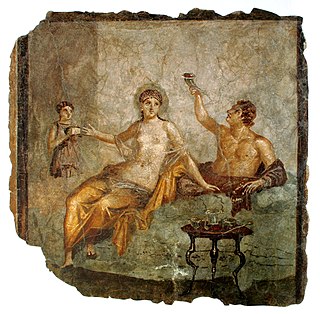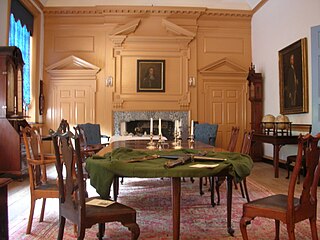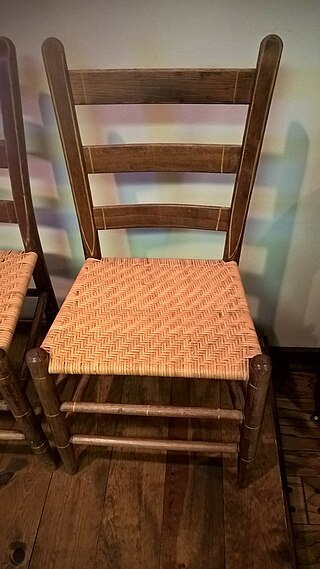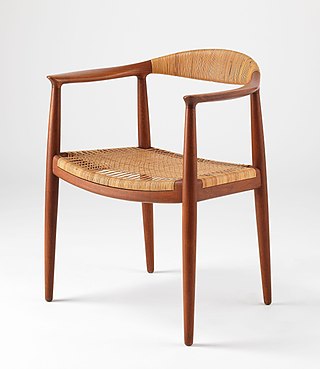
Furniture refers to movable objects intended to support various human activities such as seating, eating (tables), storing items, eating and/or working with an item, and sleeping. Furniture is also used to hold objects at a convenient height for work, or to store things. Furniture can be a product of design and can be considered a form of decorative art. In addition to furniture's functional role, it can serve a symbolic or religious purpose. It can be made from a vast multitude of materials, including metal, plastic, and wood. Furniture can be made using a variety of woodworking joints which often reflects the local culture.

A chair is a type of seat, typically designed for one person and consisting of one or more legs, a flat or slightly angled seat and a back-rest. They may be made of wood, metal, or synthetic materials, and may be padded or upholstered in various colors and fabrics.
George Hepplewhite was a cabinetmaker. He is regarded as having been one of the "big three" English furniture makers of the 18th century, along with Thomas Sheraton and Thomas Chippendale. There are no pieces of furniture made by Hepplewhite or his firm known to exist but he gave his name to a distinctive style of light, elegant furniture that was fashionable between about 1775 and 1800 and reproductions of his designs continued through the following centuries. One characteristic that is seen in many of his designs is a shield-shaped chair back, where an expansive shield appeared in place of a narrower splat design.

A commode is any of many pieces of furniture. The Oxford English Dictionary has multiple meanings of "commode". The first relevant definition reads: "A piece of furniture with drawers and shelves; in the bedroom, a sort of elaborate chest of drawers ; in the drawing room, a large kind of chiffonier." The drawing room is itself a term for a formal reception room, and a chiffonier is, in this sense, a small sideboard dating from the early 19th century.
Chairs are known from Ancient Egypt and have been widespread in the Western world from the Greeks and Romans onwards. They were in common use in China from the twelfth century, and were used by the Aztecs. In Sub-Saharan Africa, chairs were not in use before introduction by Europeans.

Wicker is the oldest furniture making method known to history, dating as far back as 5,000 years ago. It was first documented in ancient Egypt using pliable plant material, but in modern times it is made from any pliable, easily woven material. The word wicker or "wisker" is believed to be of Scandinavian origin: vika, which means "to fold" in Swedish, and vicker meaning willow. Wicker is traditionally made of material of plant origin, such as willow, rattan, reed, and bamboo, but synthetic fibers are now also used. Wicker is light yet sturdy, making it suitable for items that will be moved often like porch and patio furniture. Rushwork and wickerwork are terms used in England. A typical braiding pattern is called Wiener Geflecht, Viennese Braiding, as it was invented in 18th century Vienna and later most prominently used with the Thonet coffeehouse chair.

Restoration style, also known as Carolean style from the name Carolus, refers to the decorative and literary arts that became popular in England from the restoration of the monarchy in 1660 under Charles II until the late 1680s. Similar shifts appeared in prose style.

The Louis XV style or Louis Quinze is a style of architecture and decorative arts which appeared during the reign of Louis XV. From 1710 until about 1730, a period known as the Régence, it was largely an extension of the Louis XIV style of his great-grandfather and predecessor, Louis XIV. From about 1730 until about 1750, it became more original, decorative and exuberant, in what was known as the Rocaille style, under the influence of the King's mistress, Madame de Pompadour. It marked the beginning of the European Rococo movement. From 1750 until the King's death in 1774, it became more sober, ordered, and began to show the influences of Neoclassicism.

The President's Dining Room is a dining room located in the northwest corner of the second floor of the White House. It is located directly above the Family Dining Room on the State Floor and looks out upon the North Lawn. The Dining Room is adjacent to the Family Kitchen, a small kitchen designed for use by the First Family, and served by a dumbwaiter connected to the main kitchen on the ground floor.

A cabriole leg is one of (usually) four vertical supports of a piece of furniture shaped in two curves; the upper arc is convex, while lower is concave; the upper curve always bows outward, while the lower curve bows inward; with the axes of the two curves in the same plane. This design was used by the ancient Chinese and Greeks, but emerged in Europe in the very early 18th century, when it was incorporated into the more curvilinear styles produced in France, England and Holland.

The Queen Anne style of furniture design developed before, during, and after the time of Queen Anne, who reigned from 1702 to 1714.

A klismos or klismos chair is a type of ancient Greek chair, with curved backrest and tapering, outcurved legs.

Ancient furniture was made of many different materials, including reeds, wood, stone, metals, straws, and ivory. It could also be decorated in many different ways. Sometimes furniture would be covered with upholstery, upholstery being padding, springs, webbing, and leather. Features which would mark the top of furniture, called finials, were common. To decorate furniture, contrasting pieces would be inserted into depressions in the furniture. This practice is called inlaying.

Furniture created in the Art Nouveau style was prominent from the beginning of the 1890s to the beginning of the First World War in 1914. It characteristically used forms based on nature, such as vines, flowers and water lilies, and featured curving and undulating lines, sometimes known as the whiplash line, both in the form and the decoration. Other common characteristics were asymmetry and polychromy, achieved by inlaying different colored woods.

A ladderback chair, also ladder-back chair, slatback chair or fiddle back although that name is used less now due to the creation of the fiddle back chair. It gets its name from the horizontal spindles that serve as the back support on them and are reminiscent of a ladder.

The furniture of the Louis XV period (1715-1774) is characterized by curved forms, lightness, comfort and asymmetry; it replaced the more formal, boxlike and massive furniture of the Louis XIV style. It employed marquetry, using inlays of exotic woods of different colors, as well as ivory and mother of pearl.

Louis XIV furniture was massive and lavishly covered with sculpture and ornament of gilded bronze in the earlier part of the personal rule of King Louis XIV of France (1660–1690). After about 1690, thanks in large part to the furniture designer André Charles Boulle, a more original and delicate style appeared, sometimes known as Boulle work. It was based on the use of marquetry, the inlay of piece of ebony and other rare woods, a technique first used in Florence in the 15th century, which was refined and developed by Boulle and others working for the King. Furniture was inlaid with thin plaques of ebony, copper, mother of pearl, and exotic woods of different colors in elaborate designs.

Louis XVI furniture is characterized by elegance and neoclassicism, a return to ancient Greek and Roman models. Much of it was designed and made for Queen Marie Antoinette for the new apartments she created in the Palace of Versailles, Palace of Fontainebleau, the Tuileries Palace, and other royal residences. The finest craftsmen of the time, including Jean-Henri Riesener, Georges Jacob, Martin Carlin, and Jean-François Leleu, were engaged to design and make her furniture.

The Round Chair is an armchair designed by Hans Wegner in 1949. The chair was a collaboration of Wegner and the now-defunct furniture maker Johannes Hansen. It is still in production today by the Danish furniture manufacturer PP Møbler.


















